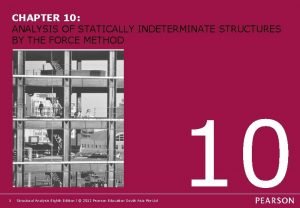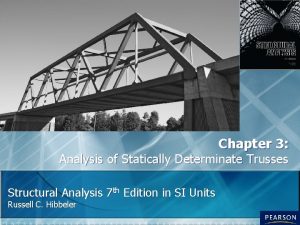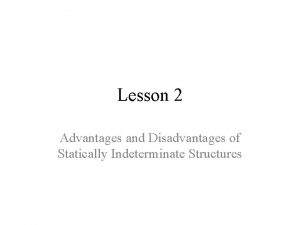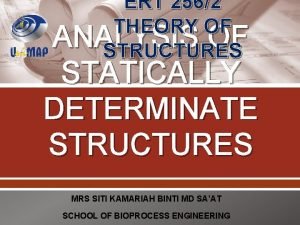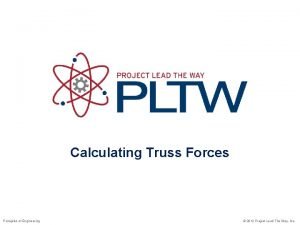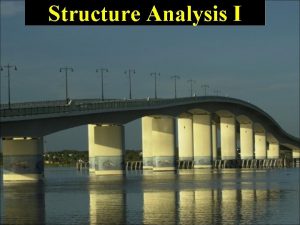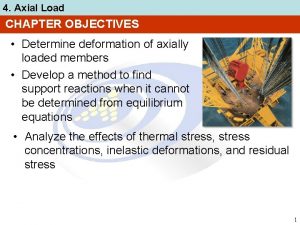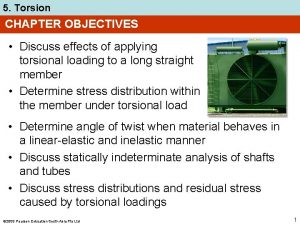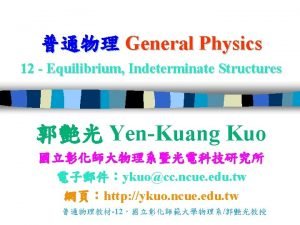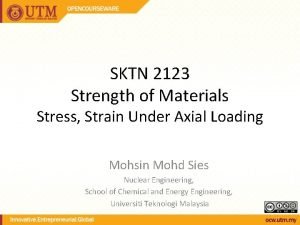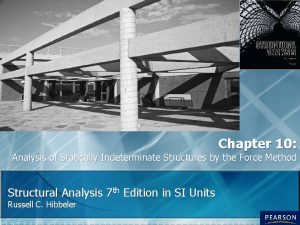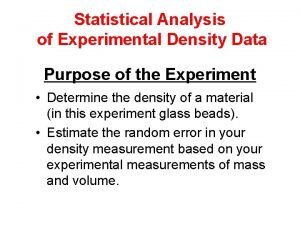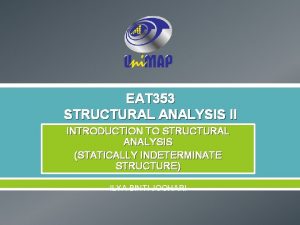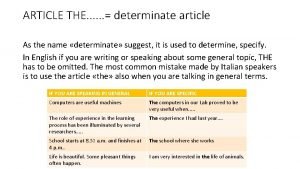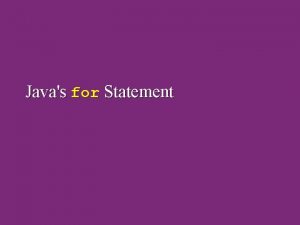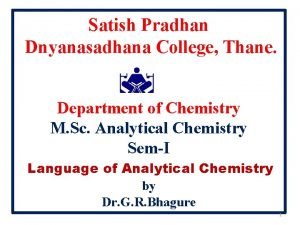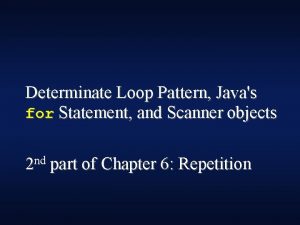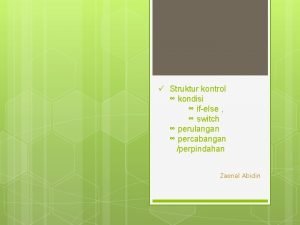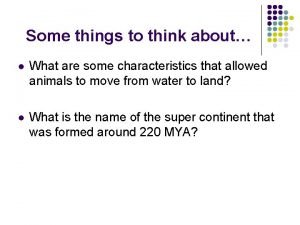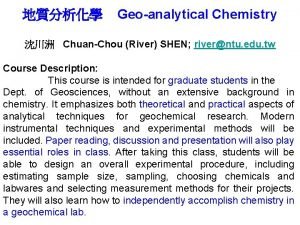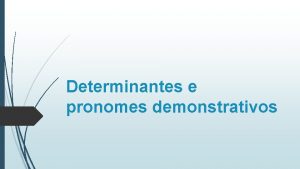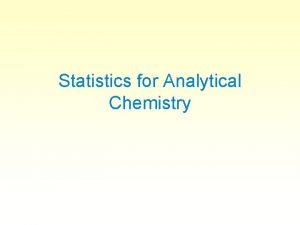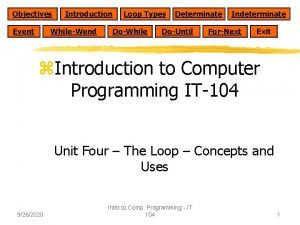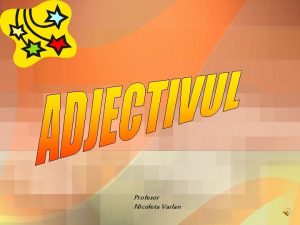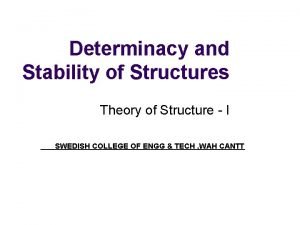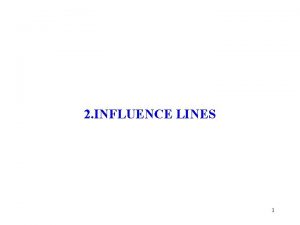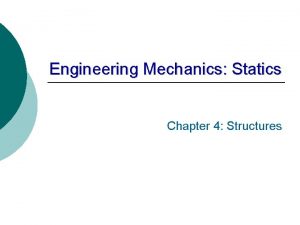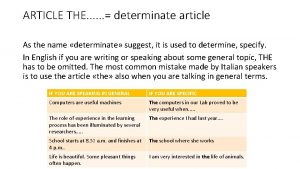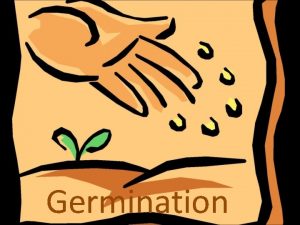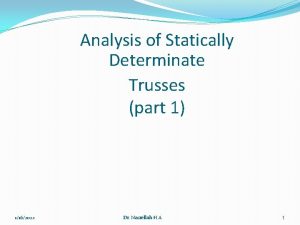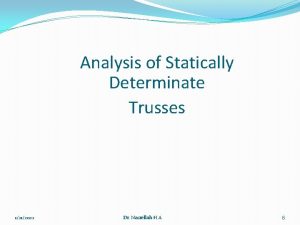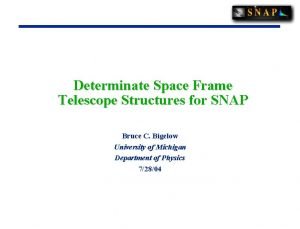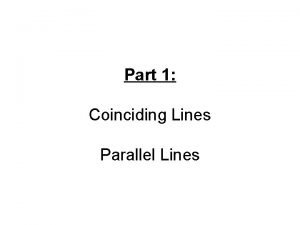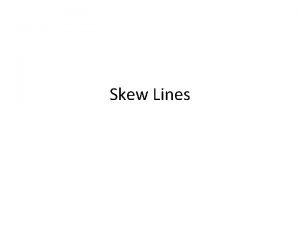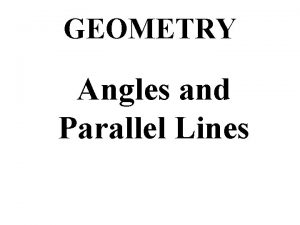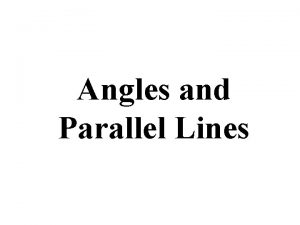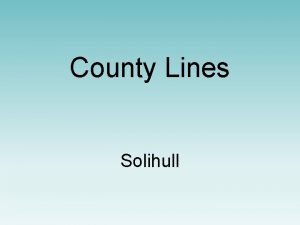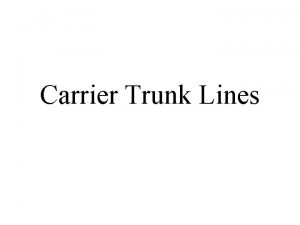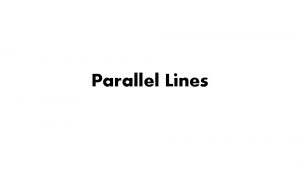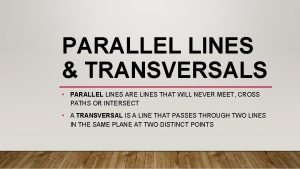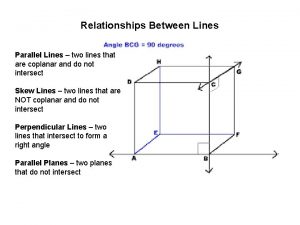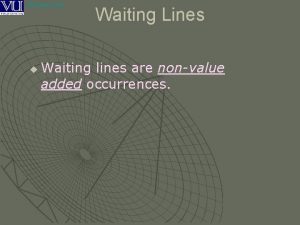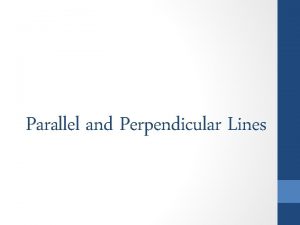6 INFLUENCE LINES FOR STATICALLY DETERMINATE STRUCTURES 1







































- Slides: 39

6. INFLUENCE LINES FOR STATICALLY DETERMINATE STRUCTURES 1

3. INFLUENCE LINES FOR STATICALLY DETERMINATE STRUCTURES - AN OVERVIEW • • Introduction - What is an influence line? Influence lines for beams Qualitative influence lines - Muller-Breslau Principle Influence lines for floor girders Influence lines for trusses Live loads for bridges Maximum influence at a point due to a series of concentrated loads • Absolute maximum shear and moment 2

3. 1 INTRODUCTION TO INFLUENCE LINES • Influence lines describe the variation of an analysis variable (reaction, shear force, bending moment, twisting moment, deflection, etc. ) at a point. . (say at C in Figure 6. 1) … … A • C B Why do we need the influence lines? For instance, when loads pass over a structure, say a bridge, one needs to know when the maximum values of shear/reaction/bendingmoment will occur at a point so that the section may be designed • Notations: – Normal Forces - +ve forces cause +ve displacements in +ve directions – Shear Forces - +ve shear forces cause clockwise rotation & - ve shear force causes anti-clockwise rotation – Bending Moments: +ve bending moments cause “cup holding water” deformed shape 3

3. 2 INFLUENCE LINES FOR BEAMS • Procedure: (1) Allow a unit load (either 1 b, 1 N, 1 kip, or 1 tonne) to move over beam from left to right (2) Find the values of shear force or bending moment, at the point under consideration, as the unit load moves over the beam from left to right (3) Plot the values of the shear force or bending moment, over the length of the beam, computed for the point under consideration 4

5

6

7

8

x/10 9

10

3. 4 QUALITATIVE INFLUENCED LINES - MULLERBRESLAU’S PRINCIPLE • The principle gives only a procedure to determine of the influence line of a parameter for a determinate or an indeterminate structure • But using the basic understanding of the influence lines, the magnitudes of the influence lines also can be computed • In order to draw the shape of the influence lines properly, the capacity of the beam to resist the parameter investigated (reaction, bending moment, shear force, etc. ), at that point, must be removed • The principle states that: The influence line for a parameter (say, reaction, shear or bending moment), at a point, is to the same scale as the deflected shape of the beam, when the beam is acted upon by that parameter. – The capacity of the beam to resist that parameter, at that point, must be removed. – Then allow the beam to deflect under that parameter – Positive directions of the forces are the same as before 11

3. 5 PROBLEMS - 3. 5. 1 Influence Line for a Determinate Beam by Muller-Breslau’s Method Influence line for Reaction at A 12

3. 5. 2 Influence Lines for a Determinate Beam by Muller. Breslau’s Method Influence Line for Shear at C Influence Line for Bending Moment at C 13

3. 5. 3 Influence Lines for an Indeterminate Beam by Muller-Breslau’s Method Influence Line for Shear at E Influence Line for Bending Moment at E 14

3. 6 INFLUENCE LINE FOR FLOOR GIRDERS Floor systems are constructed as shown in figure below, 15

3. 6 INFLUENCE LINES FOR FLOOR GIRDERS (Cont’d) 16

3. 6 INFLUENCE LINES FOR FLOOR GIRDERS (Cont’d) 3. 6. 1 Force Equilibrium Method: Draw the Influence Lines for: (a) Shear in panel CD of the girder; and (b) the moment at E. x A´ B´ C´ D´ E´ F´ A B C D E 5 spaces @ 10´ each = 50 ft F 17

3. 6. 2 Place load over region A´B´ (0 < x < 10 ft) Find the shear over panel CD VCD= - x/50 At x=0, VCD = 0 At x=10, VCD = -0. 2 C D Shear is -ve Find moment at E = +(x/50)(10)=+x/5 At x=0, ME=0 At x=10, ME=+2. 0 E +ve moment F RF=x/50 18

Continuation of the Problem x -ve 0. 2 I. L. for VCD +ve 2. 0 I. L. for ME 19

Problem Continued 3. 6. 3 Place load over region B´C´ (10 ft < x < 20 ft) VCD = -x/50 kip At x = 10 ft VCD = -0. 2 At x = 20 ft VCD = -0. 4 ME = +(x/50)(10) = +x/5 kip. ft At x = 10 ft, ME = +2. 0 kip. ft At x = 20 ft, ME = +4. 0 kip. ft C D Shear is -ve E D Moment is +ve F RF = x/50 20

x B´ C´ -ve 0. 2 0. 4 I. L. for VCD +ve 4. 0 2. 0 I. L. for ME 21

3. 6. 4 Place load over region C´D´ (20 ft < x < 30 ft) When the load is at C’ (x = 20 ft) C D Shear is -ve RF=20/50 =0. 4 VCD = -0. 4 kip When the load is at D´ (x = 30 ft) A B RA= (50 - x)/50 C D Shear is +ve VCD= + 20/50 = + 0. 4 kip 22

ME = + (x/50)(10) = + x/5 x Load P E A´ B´ C´ A B C 0. 2 D´ +ve moment RF= x/50 +ve -ve 0. 4 D I. L. for VCD +ve 2. 0 4. 0 6. 0 I. L. for ME 23

3. 6. 5 Place load over region D´E´ (30 ft < x < 40 ft) VCD= + (1 -x/50) kip A B RA= (1 -x/50) C E D Shear is +ve ME= +(x/50)(10) = + x/5 kip. ft E Moment is +ve RF= x/50 At x = 30 ft, ME = +6. 0 At x = 40 ft, ME = +8. 0 24

Problem continued x A´ B´ C´ D´ 0. 4 E´ +ve 0. 2 I. L. for VCD 2. 0 4. 0 +ve 6. 0 8. 0 I. L. for ME 25

3. 6. 6 Place load over region E´F´ (40 ft < x < 50 ft) VCD = + 1 -x/50 At x = 40 ft, VCD= + 0. 2 At x = 50 ft, VCD = 0. 0 x A 1. 0 B C D E RA= 1 -x/50 Shear is +ve ME= + (1 -x/50)(40) = (50 -x)*40/50 = +(4/5)(50 -x) x A B RA=1 -x/50 C D E F At x = 40 ft, ME= + 8. 0 kip. ft At x = 50 ft, ME = 0. 0 Moment is +ve 26

x A´ B´ 1. 0 C´ D´ E´ 0. 4 0. 2 -ve +ve F´ 0. 2 0. 4 I. L. for VCD 2. 0 4. 0 6. 0 +ve 8. 0 I. L. for ME 27

3. 7 INFLUENCE LINES FOR TRUSSES Draw the influence lines for: (a) Force in Member GF; and (b) Force in member FC of the truss shown below in Figure below G F E 20 ft 10(3)1/3 A 600 B 20 ft D C 20 ft 28

Problem 3. 7 continued 3. 7. 1 Place unit load over AB (i) To compute GF, cut section (1) - (1) G 1 -x/20 1 F E x/20 x 600 A B RA= 1 - x/60 At x = 0, FGF = 0 At x = 20 ft FGF = - 0. 77 C (1) D RD=x/60 Taking moment about B to its right, (RD)(40) - (FGF)(10 3) = 0 FGF = (x/60)(40)(1/ 10 3) = x/(15 3) (-ve) 29

PROBLEM 3. 7 CONTINUED (ii) To compute FFC, cut section (2) - (2) G x (2) F E 1 x/20 1 -x/20 reactions at nodes A 300 B RA =1 -x/60 600 D C (2) RD=x/60 Resolving vertically over the right hand section FFC cos 300 - RD = 0 FFC = RD/cos 30 = (x/60)(2/ 3) = x/(30 3) (-ve) 30

At x = 0, FFC = 0. 0 At x = 20 ft, FFC = -0. 385 20 ft I. L. for FGF -ve 0. 77 -ve 0. 385 I. L. for FFC 31

PROBLEM 3. 7 Continued 3. 7. 2 Place unit load over BC (20 ft < x <40 ft) [Section (1) - (1) is valid for 20 < x < 40 ft] (i) To compute FGF use section (1) -(1) G (1) F E (40 -x)/20 x (x-20)/20 1 reactions at nodes A 20 ft RA=1 -x/60 B C (1) (x-20) (40 -x) D RD=x/60 Taking moment about B, to its left, (RA)(20) - (FGF)(10 3) = 0 FGF = (20 RA)/(10 3) = (1 -x/60)(2 / 3) At x = 20 ft, FFG = 0. 77 (-ve) At x = 40 ft, FFG = 0. 385 (-ve) 32

PROBLEM 6. 7 Continued (ii) To compute FFC, use section (2) - (2) Section (2) - (2) is valid for 20 < x < 40 ft G (2) F (40 -x)/20 (x-20)/20 1 x FFC 300 A B RA =1 -x/60 E 600 C (2) D RD=x/60 Resolving force vertically, over the right hand section, FFC cos 30 - (x/60) +(x-20)/20 = 0 FFC cos 30 = x/60 - x/20 +1= (1 -2 x)/60 (-ve) FFC = ((60 - 2 x)/60)(2/ 3) -ve 33

At x = 20 ft, FFC = (20/60)(2/ 3) = 0. 385 (-ve) At x = 40 ft, FFC = ((60 -80)/60)(2/ 3) = 0. 385 (+ve) -ve 0. 385 0. 77 I. L. for FGF 0. 385 -ve I. L. for FFC 34

PROBLEM 3. 7 Continued 3. 7. 3 Place unit load over CD (40 ft < x <60 ft) (i) To compute FGF, use section (1) - (1) G (1) F E (x-40) 1 x (60 -x)/20 A 20 ft RA=1 -x/60 B (1) C reactions at nodes (60 -x) (x-40)/20 D RD=x/60 Take moment about B, to its left, (FFG)(10 3) - (RA)(20) = 0 FFG = (1 -x/60)(20/10 3) = (1 -x/60)(2/ 3) -ve At x = 40 ft, FFG = 0. 385 kip (-ve) At x = 60 ft, FFG = 0. 0 35

PROBLEM 3. 7 Continued (ii) To compute FFG, use section (2) - (2) reactions at nodes G F E (60 -x)/20 (x-40)/20 FFC x A 300 B RA =1 -x/60 1 C (2) 600 x-40 60 -x D RD=x/60 Resolving forces vertically, to the left of C, (RA) - FFC cos 30 = 0 FFC = RA/cos 30 = (1 -x/10) (2/ 3) +ve 36

At x = 40 ft, FFC = 0. 385 (+ve) At x = 60 ft, FFC = 0. 0 -ve 0. 385 0. 770 I. L. for FGF +ve -ve 0. 385 I. L. for FFC 37

3. 8 MAXIMUM SHEAR FORCE AND BENDING MOMENT UNDER A SERIES OF CONCENTRATED LOADS P 1 a 1 P 2 P 3 a 2 a 3 P 4 PR= resultant load P 1 a 1 P 3 P 2 P 4 a 2 a 3 C. L. A RA B L/2 C L D x PR= resultant load E RE Taking moment about A, RE L = PR [L/2 38

Taking moment about E, The centerline must divide the distance between the resultant of all the loads in the moving series of loads and the load considered under which maximum bending moment occurs. 39
 Advantages of statically indeterminate structures
Advantages of statically indeterminate structures Statically determinate truss
Statically determinate truss Advantages and disadvantages of determinate structures
Advantages and disadvantages of determinate structures Statically determinate and indeterminate structures
Statically determinate and indeterminate structures Calculating truss forces
Calculating truss forces Analysis of statically determinate trusses
Analysis of statically determinate trusses Statically determinate
Statically determinate Identify the zero force members in the truss
Identify the zero force members in the truss Approximate analysis
Approximate analysis Axial load example
Axial load example Torque
Torque Indeterminate
Indeterminate Saint venant principle
Saint venant principle Betti theorem
Betti theorem Homologous structures definition
Homologous structures definition Lower meniscus
Lower meniscus Determinate and indeterminate structure
Determinate and indeterminate structure Determinate article
Determinate article Determinate loop
Determinate loop Determinate and indeterminate structure
Determinate and indeterminate structure Determinate loop
Determinate loop Adjectiv variabil
Adjectiv variabil Apa yang disebut dengan determinate loop
Apa yang disebut dengan determinate loop Spiral and determinate cleavage
Spiral and determinate cleavage Differentiate determinate and indeterminate errors
Differentiate determinate and indeterminate errors Determinante demonstrativo e pronome demonstrativo
Determinante demonstrativo e pronome demonstrativo Differentiate determinate and indeterminate errors
Differentiate determinate and indeterminate errors Indeterminate loop in vb
Indeterminate loop in vb Analizati adjectivele din textul urmator
Analizati adjectivele din textul urmator Stability and determinacy of structures
Stability and determinacy of structures Modell för handledningsprocess
Modell för handledningsprocess Varför kallas perioden 1918-1939 för mellankrigstiden
Varför kallas perioden 1918-1939 för mellankrigstiden Vad är verksamhetsanalys
Vad är verksamhetsanalys Borstål, egenskaper
Borstål, egenskaper Vishnuismen
Vishnuismen Cks
Cks Jag har gått inunder stjärnor text
Jag har gått inunder stjärnor text Inköpsprocessen steg för steg
Inköpsprocessen steg för steg Sura för anatom
Sura för anatom Strategi för svensk viltförvaltning
Strategi för svensk viltförvaltning
